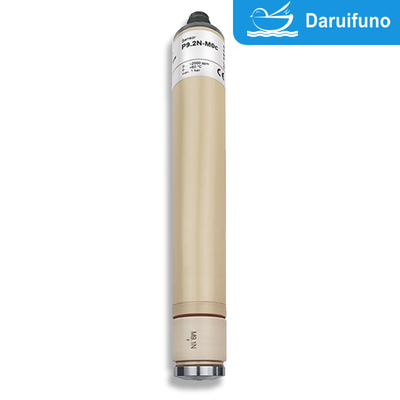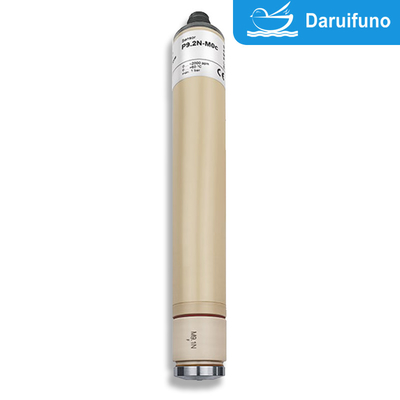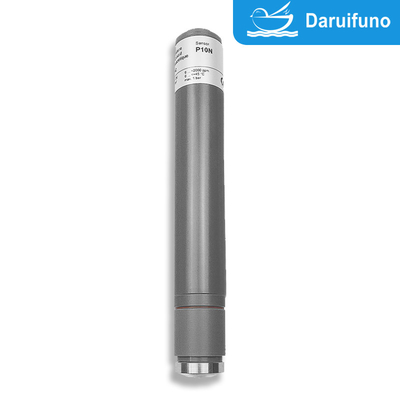Two-Electrode System Peracetic Acid Sensor For All Water Treatments High Tolerance To Chemicals
The dual-electrode system membrane peracetic acid sensor P9.3 is used in all water treatments. It has a mechanically sturdy membrane system, is resistant to surfactants, and has high tolerance to chemicals. The maximum water temperature is 60°C, and the optional range is 0~200/2000/20000 ppm.
It is a high-performance monitoring device for water treatment. Its design and process characteristics enable it to perform well in a variety of application scenarios. The following are its detailed process characteristics and advantages:
Process characteristics
Dual-electrode system design
Working electrode and reference electrode: Provide stable and accurate signals through the dual-electrode system to ensure high-precision peracetic acid detection.
Signal stability: The electrode configuration effectively reduces noise and background interference.
Membrane separation technology
Selective permeable membrane: The sensor surface is covered with a selective membrane that allows peracetic acid molecules to pass through while shielding interfering substances
Enhanced durability: Protect the electrode, reduce chemical loss, and extend the service life of the equipment.
Chemical corrosion resistance
The material is selected with high chemical corrosion resistance, which can withstand complex chemical environments and is suitable for a variety of water treatment scenarios, such as industrial wastewater and highly polluted water monitoring.
Real-time online monitoring
The sensor can be directly connected to the automated monitoring system to achieve continuous monitoring and dynamic adjustment of the water treatment process.
Automatic temperature compensation
The built-in temperature compensation function provides consistent test results under different water temperature conditions.
Advantages
High precision and sensitivity
The detection accuracy of low-concentration peracetic acid is high, which is suitable for scenarios with strict water quality requirements.
Strong anti-interference ability
The selective membrane effectively reduces the interference of other chemicals and ensures the accuracy of the measurement data.
Low maintenance requirements
The sensor diaphragm is durable and easy to replace, the equipment design is simple, and the maintenance cost is low.
The automatic calibration function reduces the frequency of manual operation.
Fast response
The response time is short, and it can quickly capture water quality changes and provide timely feedback for water treatment process adjustments.
Environmental protection and safety
No reagents are required, which reduces the generation of chemical waste and is environmentally friendly.
Long-term stability
High-tolerance materials and membrane design ensure the reliability and stability of the equipment during long-term operation.

Specifications
 |
P9.3
|
| Indicator |
Peracetic acid |
|
Application
|
All kinds of water treatment
Tensides and conductivity acids are tolerated
(e. g. bottle washing machine, CIP-plants)
|
| Measuring system |
Membrane covered, amperometric 2-electrode system |
|
Electronic
|
Analog version: - voltage output
- not galvanically isolated electronics
- analog internal data processing
- output signal: analog (analog-out/analog)
Digital version: - electronic is completely galvanically isolated
- digital internal data processing
- output signal: analog (analog-out/digital)
or
digital (digital-out/digital)
mA-version: - current output analog
- not galvanically isolated electronics
- output signal: analog (analog-out/analog)
|
|
Information about the measuring range
|
The actual slope of a sensor can vary production-related between 65% and 150% of the nominal slope
Note: With a slope > 100% the measuring range is reduced accordingly.
(Ex.: 150% slope → 67% of the specified measuring range)
|
|
Accuracy
After calibration at repeat conditions (25 °C, in drinking water) from full scale value
|
Measuring range 2000 mg/L: at 400 mg/l <2%
at 1600 mg/l <3%
|
|
Working temperature
|
Measuring water temperature: 0 … +60 °C
(no ice crystals in the measuring water)
|
| Ambient temperature: 0 … +55 °C |
| Temperature compensation |
Automatically, by an integrated temperature sensor sudden temperature
changes must be avoided
T90: approx. 3.5 min.
|
|
Max. allowed working pressure
|
Operation without retaining ring:
– 0.5 bar
– no pressure impulses and/or vibrations
|
|
Operation with retaining ring in flow cell
– 1.0 bar,
– no pressure impulses and/or vibrations
(see option 1)
|
|
Flow rate
(Incoming flow velocity)
|
approx. 15-30L/h (33 – 66 cm/s) in flow cell, small flow rate dependence is given |
| pH-range |
pH 1 – pH 8 (see Diagram „Slope of P9.3 and P10.1 versus pH“, p. 8) |
|

|
P9.3
|
|
Run-in time
|
Measuring range 200 mg/L: First start-up approx. 3 h
Measuring range 2000 mg/L: First start-up approx. 1 h
Measuring range 20000 mg/L: First start-up approx. 30 min.
|
| Response time |
T90: approx. 3.5 min. at 10 °C a
pprox. 45 sec. at 50 °C
|
| Zero point adjustment |
Not necessary |
| Calibration |
At the device, by analytical determination |
|
Interferences
|
O3: high increase of the measuring value
ClO2: increases the measuring value
H2O2: very low influence on the measuring value (reduce of the PAA-signal)
|
| Influence of conductivity acids |
1 % sulfuric acid, 1 % nitric acid or 1 % phosphoric acid in the water have no
influence to the measuring behaviour
|
| Absence of the disinfectant |
Max. 24 h |
|
Connection
|
mV version: 5-pole M12, plug-on flange
Modbus version: 5-pole M12, plug-on flange
4-20 mA version: 2-pole terminal or
5-pole M12, plug-on flange
|
|
Max. length of sensor cable
(depending on internal signal processing)
|
Analog |
< 30 m |
| Digital |
> 30 m are permissible
Maximum cable length depends on application
|
| Protection type |
5-pole M12 plug-on flange: IP68
2-pole terminal with mA-hood: IP65
|
| Material |
Elastomer membrane, PEEK, stainless steel 1.4571 |
|
Size
|
Diameter: approx. 25 mm
Length: mV version approx. 190 mm (analog signal processing)
approx.. 205 mm (digital signal processing)
Modbus version approx. 205 mm
4-20 mA version approx. 220 mm (2-pole-terminal)
approx. 190 mm (5-pole-M12)
|
| Transport |
+5 … +50 °C (Sensor, electrolyte, membrane cap) |
|

|
P9.3
|
|
Storage
|
Sensor: dry and without electrolyte no limit at +5 … +40 °C |
|
Electrolyte: in original bottle protected from sunlight at +5 … +35 °C min. 1
year or until specified EXP-Date
|
|
Membrane cap: in original packing no limit at +5 … +40 °C
(used membrane caps cannot be stored)
|
|
Maintenance
|
Regularly control of the measuring signal, min. once a week
The following specifications depend on the water quality:
Change of the membrane cap: once a year
Change of the electrolyte: every 3 - 6 months
|
|

|
|
|
Option 1:
Retaining ring
|
– When operating with pressures >0.5 bar in flow cell
– Dimensions retaining ring 29 x 23.4 x 2.5 mm, slitted, PETP
– Different positions for groove selectable
(on request)
|
 
|
Technical Data
1. P9.3 (Analog output, analog internal signal processing)
A potential-free electrical connection is necessary as the sensor electronic is not equipped with a galvanic.
 |
Measuring range |
Resolution |
Output Output resistance |
Nominal slope |
Voltage supply |
Connection |
|
P9.3H-M12
|
0…200 ppm
|
0.1 ppm
|
0…-2000 mV
1 kΩ
|
-10 mV/ppm
|
±5 - ±15 VDC
10 mA
|
5-pole M12 plug-on flange
Function of wires:
PIN1: measuring signal
PIN2: +U
PIN3: -U
PIN4: signal GND
PIN5: n. c.
|
|
P9.3N-M12
|
5…2000 ppm
|
1 ppm
|
-1 mV/ppm
|
|
P9.3L-M12
|
0.005…2 % (20000 ppm) |
0.001 %
(10 ppm)
|
-1000mV/%
(-0.1 mV/ppm)
|
| P9.3Up2000-M12 |
5…2000 ppm |
1 ppm |
0…+2000 mV
1 kΩ
|
+1 mV/ppm |
10 - 30 VDC
10 mA
|
5-pole M12 plug-on flange
Function of wires: PIN1: measuring signal PIN2: +U
PIN3: power GND PIN4: signal GND PIN5: n. c.
|
|
P9.3Up5000-M12
|
50…5000 ppm
|
1 ppm
|
+0.4 mV/ppm
|
(Subject to technical changes.)
2. P9.3 (analog output, digital internal signal processing)
analog-out / digital
- The power supply is galvanically isolated inside of the sensor.
- The output signal is galvanically isolated too, that means potential-free.
 |
Measuring range |
Resolution |
Output
Output resistance
|
Nominal slope |
Voltage supply |
Connection |
| P9.3H-An-M12 |
0 … 200 ppm |
0.1 ppm |
analog
0…-2 V
(max. -2.5 V)
1 kΩ
|
-10 mV/ppm |
9-30 VDC
approx. 20-56 mA
|
5-pole M12 plug-on flange
Function of wires:
PIN1: measuring signal
PIN2: +U
PIN3: power GND PIN4: signal GND PIN5: n. c.
|
| P9.3N-An-M12 |
5 … 2000 ppm |
1 ppm |
-1 mV/ppm |
| P9.3L-An-M12 |
0.005 … 2 %
(20000 pm)
|
0.001 %
(10 ppm)
|
-1000mV/%
(-0.1 mV/ppm)
|
| P9.3H-Ap-M12 |
0 … 200 ppm |
0.1 ppm |
analog
0…+2 V
(max. +2.5 V)
1 kΩ
|
+10 mV/ppm |
| P9.3N-Ap-M12 |
5 … 2000 ppm |
1 ppm |
+1 mV/ppm |
| P9.3L-Ap-M12 |
0.005 … 2 %
(20000 pm)
|
0.001 %
(10 ppm)
|
+1000mV/%
(+0.1 mV/ppm)
|
(Subject to technical changes.)
3. P9.3 (digital output, digital internal signal processing)
- The power supply is galvanically isolated inside of the sensor.
- The output signal is galvanically isolated too, that means potential-free.
 |
Measuring range |
Resolution |
Output
Output resistance
|
Voltage supply |
Connection |
|
P9.3H-M0c
|
0 … 200 ppm
|
0.1 ppm
|
Modbus RTU
There are no terminating resistors in the sensor.
|
9-30 VDC
approx. 20-56 mA
|
5-pole M12 plug-on flange
Function of wires: PIN1: reserved
PIN2: +U
PIN3: power GND
PIN4: RS485B
PIN5: RS485A
|
|
P9.3N-M0c
|
5 … 2000 ppm
|
1 ppm
|
|
P9.3L-M0c
|
0.005 … 2 %
(20000 pm)
|
0.001 %
(10 ppm)
|
(Subject to technical changes.)
4. P9.3 4-20 mA (analog output, analog internal signal processing)
A potential-free electrical connection is necessary as the sensor electronic is not equipped with a galvanic.
4.1 Electrical connection: 2 pole terminal clamp
 |
Measuring range |
Resolution |
Output Output resistance |
Nominal slope |
Voltage supply |
Connection |
| P9.3MA-200 |
0 … 200 ppm |
0.1 ppm |
4…20 mA uncalibrated
|
0.08 mA/ppm |
12…30 VDC
RL = 50Ω (12V)… 900Ω (30V)
|
2-pole terminal (2 x 1 mm²)
Recommended: Round cableØ 4 mm
2 x 0.34 mm²
|
| P9.3MA-2000 |
5 … 2000 ppm |
1 ppm |
0.008 mA/ppm |
| P9.3MA-2% |
0.005 … 2 %
(20000 ppm)
|
0.001 %
(10 ppm)
|
8.0 mA/%
(0.0008 mA/ppm)
|
(Subject to technical changes.)
4.2 Electrical connection: 5 pole M12 plug-on flange
 |
Measuring range |
Resolution |
Output Output resistance |
Nominal slope |
Voltage supply |
Connection |
|
P9.3MA-200-M12
|
0 … 200 ppm
|
0.1 ppm
|
4…20 mA
uncalibrated |
0.08 mA/ppm
|
12…30 VDC
RL = 50Ω
(12V)… 900Ω (30V) |
5-pole M12 plug- on flange
Function of wires:
PIN1: n. c.
PIN2: +U
PIN3: -U
PIN4: n c.
PIN5: n. c.
|
| P9.3MA-2000-M12 |
5 … 2000 ppm |
1 ppm |
0.008 mA/ppm |
|
P9.3MA-2%-M12
|
0.005 … 2 %
(20000 ppm)
|
0.001 %
(10 ppm)
|
8.0 mA/%
(0.0008 mA/ppm)
|
(Subject to technical changes.)
Spare Parts
| Type |
Membrane cap |
Electrolyte |
Emery |
O-ring |
|
P9.3
not P9.3L
and P9.3MA-2%
|
M9.3N
Art. no. 11058 |
EPS9H/W, 100 ml
Art. no. 11025
|
S2
Art. no. 11906
|
20 x 1.5 silicone
Art. no.. 11803
|
|
P9.3L
P9.3MA-2%
|
EPS9L/W, 100 ml
Art. no. 11024 |
(Subject to technical changes.)
Solope of P9.3 and P10.1 versus pH


 Your message must be between 20-3,000 characters!
Your message must be between 20-3,000 characters! Please check your E-mail!
Please check your E-mail!  Your message must be between 20-3,000 characters!
Your message must be between 20-3,000 characters! Please check your E-mail!
Please check your E-mail! 






